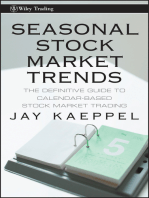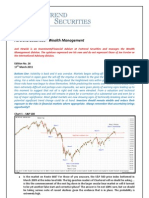Professional Documents
Culture Documents
1311 Ew Taff
1311 Ew Taff
Uploaded by
randeeps0 ratings0% found this document useful (0 votes)
125 views10 pagesew
Copyright
© © All Rights Reserved
Available Formats
PDF, TXT or read online from Scribd
Share this document
Did you find this document useful?
Is this content inappropriate?
Report this Documentew
Copyright:
© All Rights Reserved
Available Formats
Download as PDF, TXT or read online from Scribd
Download as pdf or txt
0 ratings0% found this document useful (0 votes)
125 views10 pages1311 Ew Taff
1311 Ew Taff
Uploaded by
randeepsew
Copyright:
© All Rights Reserved
Available Formats
Download as PDF, TXT or read online from Scribd
Download as pdf or txt
You are on page 1of 10
AWESOME CHARTS
Charts tell the truth. Lets look at some charts.
Figure 1
Commodities are in a bear market. Figure 1 proves that the Feds feverish quantitative easing (QE)i.e. record
at-money inatingis not driving overall prices of goods higher. The bear market in commodities began two
months before the Feds massive asset-buying program began. Despite the Feds inating at a 33% rate annually for
ve straight years, commodities are still slipping lower. This is yet another example of the non-existence of external
causality on nancial market prices. Such events are results, not causes. The Fed is not pro-acting but reacting.
Going into the 2008 peak, sentiment was a key indicator showing that belief in higher prices was rampant.
When speaking at a conference in the fall of 2007, I saw hundreds of attendees lined up for the equivalent of half a
city block to have an investment guru sign his new commodity-investing book for them. While the author himself
had bought commodities early, these fans were getting on board only in the nal months. Few of them would even
have read a book on commodity investing in 1999.
P.O. Box 1618 Gainesville, GA 30503 USA 770-536-0309 800-336-1618 FAX 770-536-2514
November 2013 Issue
November 15, 2013
Figure 1
The Elliott Wave TheoristNovember 15, 2013
Learn how you can get Robert Prechters unique insight and analysis each month in The Elliott Wave Theorist.
Visit http://www.elliottwave.com/wave/EWT-CLUBEWIA
Figure 2
The September 2013 issue of EWT called for another peak in gasoline prices, and it happened. Gas prices have
been falling despite the slightly expanding economy and despite record QE. The peak price in July was the fth in a
series of lower peaks since 2008. Figure 2 is the same chart shown then but with prices updated. Gas now sells for the
lowest price in nearly three years. In an unusual development, todays paper sports the headline, Fuel Costs Might
Have Hit Bottom. At the short term lows in gas prices over the past two years, articles reported experts predictions
of still-lower prices. Todays willingness to call a bottom suggests that gas prices are going much lower.
Figure 2
Figures 3 and 4
Figure 3, published ten days after gold hit its all-time high, is from the September 2011 EWT. Since the Fed
was created in 1913, gold at that time had risen 93 times in value while the Consumer Price Index had risen only 23
times. In other words, having climbed four times as much as the CPI, gold was expensive. Figure 4 updates these
charts. The CPI has barely budged since then, but gold has fallen so that its 100-year gain is only about three times
that of the CPI. The gap is closing, but there is still a lot of room on the downside for gold.
The Elliott Wave TheoristNovember 15, 2013
Learn how you can get Robert Prechters unique insight and analysis each month in The Elliott Wave Theorist.
Visit http://www.elliottwave.com/wave/EWT-CLUBEWIA
Figure 4
Figure 3
The Elliott Wave TheoristNovember 15, 2013
Learn how you can get Robert Prechters unique insight and analysis each month in The Elliott Wave Theorist.
Visit http://www.elliottwave.com/wave/EWT-CLUBEWIA
Figure 5
The Elliott Wave Financial Forecast showed Figure 5 two years ago, in October 2011. The Elliott wave labeling
shown that month on this chart and in Figure 3 indicated the end of the bull market at both Cycle and Supercycle
degree. As you can see, the last chance to sell (not buy) coincided with the Feds launching of its trillion-dollar-a-
year bond and mortgage-buying program.
Figure 5
Figure 6
Figure 6, also shown in EWFF two years ago, cited a dozen indications of extreme optimism in the gold market
during its nal year of rise. Some of these citations are amazing: Societe Generale announced that golds fair value
was $10,000/oz. People polled by Gallup cited gold as the single best long-term investment. (In 1999, investors didnt
know gold existed.) Ninety-eight percent of futures traders polled for the Daily Sentiment Index (trade-futures.com)
were bullish on gold. And the kicker: Central banks, after selling gold a decade earlier near the lows, were buying
it. Many speakers on the circuit cited this as a reason gold would soar, but it was a top signal.
With gold now down by 1/3, optimism has waned substantially. But investors have not reached the level of
pessimism toward gold that existed on February 12, 2001, when a major article was sub-headed, Nobody expects
gold prices to turn up soon, and one of the typical comments recorded was, There doesnt seem to be anything on
the horizon that will make gold prices go up. Gold at the time was days from its low at $253/oz. When gold reaches
its next major bottom, well see articles with similar comments and quotes.
The Elliott Wave TheoristNovember 15, 2013
Learn how you can get Robert Prechters unique insight and analysis each month in The Elliott Wave Theorist.
Visit http://www.elliottwave.com/wave/EWT-CLUBEWIA
Figure 7
The stock market top has eluded us. Prices
have repeatedly passed what we thought were
terminal junctures. But the charts just keep
getting more bearish.
The top graph in Figure 7 shows the S&P
that everyone is watching. New bull market,
right? Wrong. The middle graph shows the real
S&P, which has been in a bear market since the
rst quarter of 2000. The Feds liquidity has
re-fattened the banks, and bankers in turn are
lending the new money to wealthy institutional
speculators, who use it as collateral to buy
stocks on ten to thirty times leverage. This is
not a bull market but a hyped-up bear market
rally. As Elliott Wave Principle (p.81) said
35 years ago, If the analyst can easily say to
himself, There is something wrong with this
market, chances are its a B wave [a bear market
rally]. There is something not just wrong but
sick about a market that is making new all-time
highs for seven months on the subterfuge of
a purposely debased measuring unit and the
central banks nancing of speculators with
values stolen from savers.
Figure 7
Figure 6
The Elliott Wave TheoristNovember 15, 2013
Learn how you can get Robert Prechters unique insight and analysis each month in The Elliott Wave Theorist.
Visit http://www.elliottwave.com/wave/EWT-CLUBEWIA
The huge difference between the top two
lines on Figure 7 highlights how remarkable
it is that nominal prices for gold, silver and
commodities are down 30%-60% from their
highs. In real terms, they have fallen even
further.
The lower graph on the chart conrms
our interpretation that the post-2000 rallies
are bear-market rallies. Main Street knows
that the recovery is phony, and its assessments
of the economy are in lock-step with the real
S&P, not the phony one. The depression is
ongoing, and counterfeiting money cant
stop it.
Figure 8
Big-cap institutional issues are pushing
up the popular averages, but the NYSE
indexa broad measure comprising 1860
stockshasnt even passed its 2007 high in
nominal terms, much less in real terms. Per
Figure 8, the broad list of stocks is still in a
bear market no matter how you look at it.
Figure 9
This year, EWT and EWFF have showed two dozen charts of sentiment indicators at or near all-time expressions
of optimism, and here are two more. Figure 9 shows that in the second-to-last week of October, the public poured
more money into various U.S. stock funds than at any time in at least seven years, which includes the 2007 stock
market top.
Figure 8
Figure 9
The Elliott Wave TheoristNovember 15, 2013
Learn how you can get Robert Prechters unique insight and analysis each month in The Elliott Wave Theorist.
Visit http://www.elliottwave.com/wave/EWT-CLUBEWIA
Figure 10
All this stock buying has created a lopsided investment ratio among fund sectors. As shown in Figure 10, the
percentage of money in Rydexs conservative money-market funds as opposed to speculative stock market funds is
the lowest since 2001, which is just after the all-time high in the real value for stocks (shown in the middle graph
of Figure 7).
Figure 10
Figure 11
So much for the public. What about professional advisors? Figure 11 shows that newsletter advisors polled
by Investors Intelligence have just reached the lowest percentage of bears since 1987, over a quarter century ago!
Under the Elliott wave model, that optimism made sense, because the market was in the third Primary wave of the
bull market, the healthiest part of the rise. Still, those peak readings led to the second-biggest stock market crash of
the 20
th
century. The reading today, while not quite as extreme, is lower than that at the stock market peak of 2007,
lower than at the peak of 2000, and just one-quarter of the percentage of bears recorded near major lows. In addition,
the latest Daily Sentiment Index shows 90% bulls among S&P futures traders. Now observe on the upper graph that
the S&P 500 index is right at the upper line of a trend channel dating back to the 2009 low. Overall, then, we have
near-record optimism at an all-time high, right at a point of trendline resistance.
Figure 12
Per Figure 12, the NASDAQ Composite and NASDAQ 100 indexes are likewise at the upper ends of channels.
They are also touching resistance lines that go back a decade. The S&P and NASDAQ, then, are simultaneously
reaching major resistance in an environment of peak optimism.
The Elliott Wave TheoristNovember 15, 2013
Learn how you can get Robert Prechters unique insight and analysis each month in The Elliott Wave Theorist.
Visit http://www.elliottwave.com/wave/EWT-CLUBEWIA
F
i
g
u
r
e
1
1
The Elliott Wave TheoristNovember 15, 2013
Learn how you can get Robert Prechters unique insight and analysis each month in The Elliott Wave Theorist.
Visit http://www.elliottwave.com/wave/EWT-CLUBEWIA
Figure 13
Hedge funds arent the only
entities using leverage in record
amounts. Individuals are using
it, too. Figure 13 shows that
margin debt at brokerage rms
has now reached an all-time high.
Leveraged buying by institutions
and margin buying by individuals
explains how the averages shown
in all the previous charts got to
where they are. Its just another
big debt-nanced bubble, like
the one in housing that ended
in 2006.
Figure 14
The Dow-Jones Utility
Average sported ve waves down
from April to June, indicating
that its bear market is already
Figure 12
Figure 13
The Elliott Wave TheoristNovember 15, 2013
Learn how you can get Robert Prechters unique insight and analysis each month in The Elliott Wave Theorist.
Visit http://www.elliottwave.com/wave/EWT-CLUBEWIA
underway (see Figure 14). The recovery is taking an A-B-C
shape, so its counter-trend rally is nearly over. Investors tend
to buy utilities for dividend yield. With the bond market having turned from major bull to major bear in the summer
of 2012, utilities are going to face stiff competition from rising bond yields.
Figure 15
The short term chart of the Dow published on November 7 showed ve waves up from the October 9 low. But
wave 9 stretched into a triangle, from which prices have thrust. The thrust is weak, with the past three up days
averaging less than a 2:1 ratio of advances to declines. The combination of wave counts in Figures 11 and 15 indicates
the imminent end of the entire rise from 2009.
The stock market has been the only major nancial sector holding up. Its been frustrating, but it wont last.
When wave c in the Dow gets going, the rush to the exits across all markets will be both frightening and exhilarating.
Figure 14
Figure 15
Boldly independent and refreshingly contrary, Prechters Elliott Wave Theorist is
dedicated to bringing you a tomorrows news today perspective on upcoming
market activity and social trends. It exposes commonly held market myths and
replaces them with a more accurate depiction of how markets behave and why.
Each issue delivers unparalleled insight into the marketplace.
The scope is wide, the content profound and the relevance universal.
Each Elliott Wave Theorist pushes the envelope of wave research.
Preview the topics covered in Bobs Theorist and fnd out how you can get the three latest
issues for just $20 >>
Or visit http://www.elliottwave.com/wave/EWT-CLUBEWIA
ROBERT PRECHTERS ELLIOTT WAVE THEORIST DELIVERS UNIQUE INSIGHT
AND ANALYSIS EACH MONTH THAT WILL HELP YOU INVEST INDEPENDENTLY
The Elliott Wave Theorist is published by Elliott Wave International, Inc. Mail: P.O. Box 1618, Gainesville, Georgia,
30503, U.S.A. Phone: 770-536-0309. All contents copyright 2013 Elliott Wave International, Inc. Reproduction,
retransmission or redistribution in any form is illegal and strictly forbidden, as is continuous and regular dissemination
of specic forecasts or strategies. Otherwise, feel free to quote, cite or review if full credit is given. Typos and minor
errors are corrected in the online version, which is the ofcial nal version of each issue. Subscribers will be notied
by email if substantive changes are made.
You might also like
- Right Side Seminar7october2018 FinalDocument73 pagesRight Side Seminar7october2018 Finalscreenseasier0mNo ratings yet
- Elliot WavesDocument7 pagesElliot WavesSnehal Panchal100% (1)
- NQSystem Scalping PDFDocument37 pagesNQSystem Scalping PDFharish2005100% (4)
- Elliott Wave in The 21st Century: by Matt Blackman With Mike GreenDocument26 pagesElliott Wave in The 21st Century: by Matt Blackman With Mike GreennetcrazymNo ratings yet
- C059 - 32 PDF CMT Level I 2018 TOCDocument11 pagesC059 - 32 PDF CMT Level I 2018 TOCismail-133% (3)
- Traders ClassroomDocument71 pagesTraders ClassroomCharlie Sheen33% (3)
- IFTA CFTe SyllabusDocument122 pagesIFTA CFTe SyllabusMetin Aza100% (2)
- Multifactor Explanations of Asset Pricing AnomaliesDocument32 pagesMultifactor Explanations of Asset Pricing Anomaliesmubasheralijamro0% (1)
- Harmonic Elliott Wave Article by Ian Copsey PDFDocument12 pagesHarmonic Elliott Wave Article by Ian Copsey PDFMolina CleberNo ratings yet
- Glenn Neely - Mastering Elliott Waves PDFDocument170 pagesGlenn Neely - Mastering Elliott Waves PDFVijaykumar D SNo ratings yet
- Market Technicians AssociationDocument41 pagesMarket Technicians AssociationScarlett Cheek100% (2)
- Fibonacci: Cheat SheetDocument4 pagesFibonacci: Cheat SheetKiran Sk44% (9)
- W8WJRZIBZPERGJQBI2GWDocument1,021 pagesW8WJRZIBZPERGJQBI2GWVinoth Kumar100% (6)
- Option Trading With Elliott WaveDocument42 pagesOption Trading With Elliott WaveANIL1964100% (4)
- Fibonacci and Elliott WaveDocument94 pagesFibonacci and Elliott Waveicemansva80% (15)
- Fractal Wave Algorithm For Trading Stocks MarketDocument17 pagesFractal Wave Algorithm For Trading Stocks Markettaiyawut100% (1)
- Fibonacci Golden Zone Strategy PDFDocument31 pagesFibonacci Golden Zone Strategy PDFPruthvish Shukla67% (3)
- Death To Diversification: What It Means For Your Investment StrategyDocument13 pagesDeath To Diversification: What It Means For Your Investment StrategyClipper52aNo ratings yet
- Seasonal Stock Market Trends: The Definitive Guide to Calendar-Based Stock Market TradingFrom EverandSeasonal Stock Market Trends: The Definitive Guide to Calendar-Based Stock Market TradingNo ratings yet
- Stocks, Bonds, U.S. Dollar Index, Precious Metals and Special OpportunitiesDocument13 pagesStocks, Bonds, U.S. Dollar Index, Precious Metals and Special OpportunitiesvedrankNo ratings yet
- 2020 07GMPb PDFDocument43 pages2020 07GMPb PDFImre GamsNo ratings yet
- 1512 GMPDocument57 pages1512 GMPpuneet aroraNo ratings yet
- Futures Junctures: SoftsDocument6 pagesFutures Junctures: SoftsBudi MulyonoNo ratings yet
- 2001.01.06 - Elliott Wave Theorist - Bear Market StrategiesDocument3 pages2001.01.06 - Elliott Wave Theorist - Bear Market StrategiesBudi MulyonoNo ratings yet
- Curso at - Credit SuisseDocument32 pagesCurso at - Credit SuisseseehariNo ratings yet
- Glenn Neely - Mastering Elliott Wave - 수정Document169 pagesGlenn Neely - Mastering Elliott Wave - 수정account personalNo ratings yet
- Elliott Wave Theory Is A Collection of Complex TechniquesDocument6 pagesElliott Wave Theory Is A Collection of Complex TechniquessriNo ratings yet
- Hidden DivergenceDocument5 pagesHidden Divergencesharvan003No ratings yet
- AHG Bible Full VersionDocument100 pagesAHG Bible Full Versionbarber bobNo ratings yet
- Who Is Robert PrechterDocument8 pagesWho Is Robert PrechterChukwuemeka Onyeukwu SixtusNo ratings yet
- The Isolation Approach To Elliott Wave Analysis: by Steve GriffithsDocument6 pagesThe Isolation Approach To Elliott Wave Analysis: by Steve Griffithssam2976No ratings yet
- Market Technician No 54Document13 pagesMarket Technician No 54ppfahdNo ratings yet
- Robert Prechter Is Awaiting A DepressionDocument6 pagesRobert Prechter Is Awaiting A Depressionabcd1234No ratings yet
- MR MarketDocument64 pagesMR MarketRaymondTuskNo ratings yet
- Elliott Wave International 5 PDFDocument4 pagesElliott Wave International 5 PDFawdasfdsetsdtgfrdfNo ratings yet
- Edition 24 - Chartered 16 February 2011Document11 pagesEdition 24 - Chartered 16 February 2011Joel HewishNo ratings yet
- Why - After 30 Years - Is Mastering Elliott Wave Still RelevantDocument4 pagesWhy - After 30 Years - Is Mastering Elliott Wave Still Relevantali reza0% (1)
- Futures West 1998Document30 pagesFutures West 1998Muh Akbar ZNo ratings yet
- Edition 26 - Chartered 17th March 2011Document7 pagesEdition 26 - Chartered 17th March 2011Joel HewishNo ratings yet
- Do Elliott Waves OccurDocument4 pagesDo Elliott Waves Occurbodhibuddha100% (1)
- Wiley - Trade Stocks and Commodities With The Insiders - Secrets of The COT Report - 978-0-471-74125-1Document2 pagesWiley - Trade Stocks and Commodities With The Insiders - Secrets of The COT Report - 978-0-471-74125-1jarullah jarullahNo ratings yet
- Books For CMT Level 1 PDFDocument1 pageBooks For CMT Level 1 PDFDinesh CNo ratings yet
- CMT Level 1Document2 pagesCMT Level 1Raj KumarNo ratings yet
- A Tale of Two TradersDocument4 pagesA Tale of Two Tradersmayankjain24inNo ratings yet
- Elliott Wave TheroistDocument5 pagesElliott Wave TheroistANIL1964100% (1)
- Stocks, Bonds, U.S. Dollar Index, Precious Metals and Special OpportunitiesDocument12 pagesStocks, Bonds, U.S. Dollar Index, Precious Metals and Special OpportunitiesTRIFMAKNo ratings yet
- 3 Seminario Elliott WaveDocument9 pages3 Seminario Elliott Wavebatraz79100% (2)
- How To Predict Market's Tops & Bottoms Using Elliott Wave PrincipleDocument20 pagesHow To Predict Market's Tops & Bottoms Using Elliott Wave PrincipleHery100% (1)
- Elliot Waves IntroductionDocument59 pagesElliot Waves IntroductionGautam Dua100% (1)
- TA Books Bibliography PDFDocument3 pagesTA Books Bibliography PDFgeorgez111No ratings yet
- Lecture #1 - FinalDocument38 pagesLecture #1 - FinalGangsta101No ratings yet
- Technical Analysis MagDocument44 pagesTechnical Analysis Magmerc2100% (1)
- Game Plan: Scenario 1 - Highs Made First Break All Time High 2480.50 With Buying of Good QualityDocument3 pagesGame Plan: Scenario 1 - Highs Made First Break All Time High 2480.50 With Buying of Good QualityRICARDONo ratings yet
- Japanese Equities: A Practical Guide to Investing in the NikkeiFrom EverandJapanese Equities: A Practical Guide to Investing in the NikkeiNo ratings yet
- Elliott Wave Theory, Cycle, Rules and Personality ExplainedDocument3 pagesElliott Wave Theory, Cycle, Rules and Personality ExplainedanishghoshNo ratings yet
- Dynamic Trader Daily Report: Initial Stop PlacementDocument6 pagesDynamic Trader Daily Report: Initial Stop PlacementBudi MuljonoNo ratings yet
- Commodities As An Asset ClassDocument7 pagesCommodities As An Asset ClassvaibhavNo ratings yet
- Glenn Neely Neowave, Inc.: Trend Next 5 DaysDocument1 pageGlenn Neely Neowave, Inc.: Trend Next 5 Dayssadha27No ratings yet
- Patterns Impulse Patterns Corrective Pat PDFDocument29 pagesPatterns Impulse Patterns Corrective Pat PDFChuks OsagwuNo ratings yet
- Elliott Wave International 1 PDFDocument5 pagesElliott Wave International 1 PDFawdasfdsetsdtgfrdf100% (1)
- Jeffrey Kennedy Diagonal TrianglesDocument3 pagesJeffrey Kennedy Diagonal Trianglesjkent88No ratings yet
- Systemic Liquidity Risk and Bipolar Markets: Wealth Management in Today's Macro Risk On / Risk Off Financial EnvironmentFrom EverandSystemic Liquidity Risk and Bipolar Markets: Wealth Management in Today's Macro Risk On / Risk Off Financial EnvironmentNo ratings yet
- The Forex Chartist Companion: A Visual Approach to Technical AnalysisFrom EverandThe Forex Chartist Companion: A Visual Approach to Technical AnalysisNo ratings yet
- Volatility-Based Technical Analysis: Strategies for Trading the InvisibleFrom EverandVolatility-Based Technical Analysis: Strategies for Trading the InvisibleNo ratings yet
- 7 Steps To Thinking Like A GeniusDocument7 pages7 Steps To Thinking Like A GeniusrandeepsNo ratings yet
- APL InvestorDocument26 pagesAPL InvestorrandeepsNo ratings yet
- PLTVF Factsheet February 2014Document4 pagesPLTVF Factsheet February 2014randeepsNo ratings yet
- 2014 Business-Management CATDocument71 pages2014 Business-Management CATrandeepsNo ratings yet
- Investment Guide: March 20, 2014Document2 pagesInvestment Guide: March 20, 2014randeepsNo ratings yet
- Ambit1 PDFDocument1 pageAmbit1 PDFrandeepsNo ratings yet
- Aug 11Document18 pagesAug 11randeepsNo ratings yet
- Esignal Manual Ch9Document6 pagesEsignal Manual Ch9umaformanatural100% (1)
- Certified Financial Technician (Cfte) I & Ii Syllabus & Reading MaterialDocument8 pagesCertified Financial Technician (Cfte) I & Ii Syllabus & Reading MaterialNagavardhanNo ratings yet
- How To Trade The Highest-Probability Opportunities - Price GapsDocument58 pagesHow To Trade The Highest-Probability Opportunities - Price GapsabelNo ratings yet
- Lista Libri GannDocument14 pagesLista Libri Ganndavetrader50% (2)
- Technical Analysis: Prepared byDocument75 pagesTechnical Analysis: Prepared byShare Knowledge NepalNo ratings yet
- Utility Manual For The Precision Ratio Compass - Elliott Wave ...Document73 pagesUtility Manual For The Precision Ratio Compass - Elliott Wave ...Seyed Ali Hoseyni AnarakiNo ratings yet
- Pattern Analysis: A Capsule Summary of The Wave PrincipleDocument34 pagesPattern Analysis: A Capsule Summary of The Wave PrincipleCarlos XaplosNo ratings yet
- Elliott Wave Theory Is A Collection of Complex TechniquesDocument6 pagesElliott Wave Theory Is A Collection of Complex TechniquessriNo ratings yet
- GS TA IntroTechnicalsDocument68 pagesGS TA IntroTechnicalsZg ZgNo ratings yet
- Sharpen Your Trading SkillsDocument22 pagesSharpen Your Trading SkillsMihai BartaNo ratings yet
- Chartered Market Technician (CMT) Program Level 2: May 2013 Reading AssignmentsDocument4 pagesChartered Market Technician (CMT) Program Level 2: May 2013 Reading Assignmentsανατολή και πετύχετεNo ratings yet
- Switztrader Trading BookDocument57 pagesSwitztrader Trading BookJoseph ChukwuNo ratings yet
- How To Predict Market's Tops & Bottoms Using Elliott Wave PrincipleDocument20 pagesHow To Predict Market's Tops & Bottoms Using Elliott Wave PrincipleHery100% (1)
- Market Technician No 44Document16 pagesMarket Technician No 44ppfahdNo ratings yet
- Problem Statement EDITDocument30 pagesProblem Statement EDITSameer KambleNo ratings yet
- Awesome Traders Guide To Elliott Wave + A Simple Trading Strategy!Document24 pagesAwesome Traders Guide To Elliott Wave + A Simple Trading Strategy!lasersmart100% (2)
- 1002 MaddenDocument55 pages1002 MaddenAM PM100% (1)
- Indicator Soup: Enhance Your Technical Trading - September 2007 - by Darrell JobmanDocument5 pagesIndicator Soup: Enhance Your Technical Trading - September 2007 - by Darrell JobmanLuisa HynesNo ratings yet
- The New Elliot Wave RuleDocument40 pagesThe New Elliot Wave RuleUlisses76100% (3)
- TradingKey PDFDocument121 pagesTradingKey PDFjgds123100% (1)
- Elliott Wave Cheat Sheet FINAL PDFDocument6 pagesElliott Wave Cheat Sheet FINAL PDFmdajobsNo ratings yet






























































































